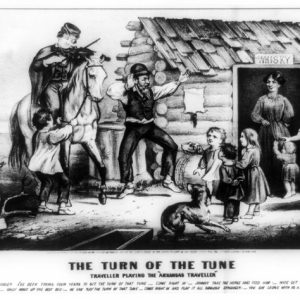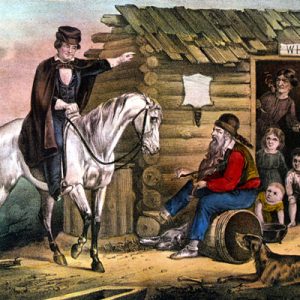calsfoundation@cals.org
Sandford C. "Sandy" Faulkner (1803?–1874)
Sandford C. (Sandy) Faulkner is an iconic individual from Arkansas’s early statehood. Although he never held elective office, his political and economic activity made a significant contribution to the development of the young state. Moreover, Faulkner is largely responsible for the story of the “Arkansas Traveler,” which has shaped the image of Arkansas since the 1840s.
Sandy Faulkner was born on March 3, most likely in 1803, in Scott County, Kentucky, to Nicholas Faulkner and Sally Fletcher Faulkner. Much confusion surrounds Faulkner’s early history; many sources spell his first name “Sanford,” and one researcher even suggests that at birth he was given the name “Sanderson.” The 1850 census appears to record his age as forty-four, suggesting that he was born in 1806; this year is repeated in some sources, including Faulkner’s tombstone. One record suggests that his middle name may have been Clinton, although that name is not supported by any other material.
Faulkner’s family had moved progressively west from Virginia over several generations. Nicholas Faulkner kept a tavern near Georgetown, Kentucky, until the family moved to Arkansas around 1829. The family established two large cotton plantations near Point Comfort (Chicot County) and is said to have, for a time, owned the largest number of slaves west of the Mississippi River. Management of the plantations fell to Faulkner, but this duty did not occupy all of his time. Faulkner served as aide-de-camp to the commanding general of the Second Brigade of Arkansas Militia headquartered at the mouth of the White River in 1831, an experience that led to his being known in later years as Colonel Faulkner. He was active in territorial and state politics, running (unsuccessfully) for the legislative council of the territory in 1833 and being defeated in campaigns for the state Senate in 1854 and for the state House of Representatives in 1858. In 1838, the Arkansas General Assembly appointed Faulkner a commissioner of Chicot County. By 1831, he was married to Evelene M. Peak; they had nine children.
Faulkner was also named president of the Columbia (Chicot County) branch of the Real Estate Bank of Arkansas. This bank, established by the state’s 1836 constitution and operating in several locations across the state by the end of 1837, mortgaged farm property (mostly in the Delta region of Arkansas) and sold stock certificates and bonds. By the end of 1839, the bank was making loans both to stockholders and to the general public. A national economic downturn began in 1837 and persisted into the following decade, and questionable bonds from the bank were sold in New York City and even in London, bringing about the failure of the Real Estate Bank, as well as the State Bank of Arkansas. Matters quickly grew worse—so bad, in fact, that in 1846, the Arkansas General Assembly amended the state constitution to prohibit the incorporation or establishment of banks in the state. About $1 million of investor money was lost by the Columbia branch of the Real Estate Bank, of which Faulkner was president. In 1842, he was named one of three trustees of the struggling institution, and his personal debts climbed to unmanageable proportions. Faulkner’s land and slaves in Chicot County were possessed and sold by creditors. In 1839, he had established a second residence in Little Rock (Pulaski County), which now became his family’s permanent home.
In the midst of these financial crises, Faulkner achieved his most memorable accomplishment, creating the legacy for which he is most remembered. Canvassing the state with career politicians Ambrose H. Sevier, Archibald Yell, Chester Ashley, and William S. Fulton, Faulkner came to the hut of a settler, usually unnamed but identified in one source as Waller Wright. According to Faulkner’s frequent retelling of the event, the settler was at first surly and uncommunicative but became more welcoming when Faulkner proved able to complete the fiddle tune that the settler had been playing. Generally when Faulkner told the story, only he and the settler participated in the conversation. Faulkner’s story of the “Arkansas Traveler” rapidly became part of the state’s folklore, leading to a famous painting and lithograph depicting the event, as well as to frequent performance of the tune, which Faulkner often played as part of his narrative. The story, with many variations, appears in countless collections of stories about Arkansas. Some folklorists claim that Faulkner wrote the tune to accompany his story, but this assertion cannot be proved.
Faulkner continued to live in Little Rock during the twenty years after this event. When the Little Rock Arsenal was surrendered to the state of Arkansas by Captain James Totten in 1861, Faulkner was named commander and military storekeeper of the installation (while also serving as a captain of artillery), a position he held until Little Rock was captured by the Federal army in 1863. Faulkner fled to Tyler, Texas, remaining there until the war had ended.
In 1865, Faulkner returned to Arkansas and attempted to resume farming, but he had no money to hire workers, and so lost his remaining farm acreage. In 1873, he attempted to form a statewide association of “Old Settlers of Arkansas,” limiting membership to people who had been citizens of the state at the time of its organization in 1836. Faulkner chaired the Pulaski County chapter of the association, but it failed to materialize. That same year, the General Assembly named the sixty-ninth county of the state (one of nine created that year) Faulkner County in his honor. The next year, the Constitutional Convention meeting in Little Rock appointed Faulkner as its doorkeeper, largely because the members of the convention were aware of his financial needs and increasing health problems.
Faulkner died in his home in Little Rock on August 4, 1874. The convention adjourned to attend his funeral at the Christian Church in Little Rock, where Faulkner had recently been baptized, and his burial at Mount Holly Cemetery. His eight pallbearers included former governors Henry Rector and Harris Flanagin and future governor Thomas Churchill, as well as other prominent politicians and community leaders. A marker was placed at Faulkner’s grave by the Pulaski County Historical Society in 1954 and was dedicated on January 23, 1955.
For additional information:
Brannon, Sheila Farrell. Tribute to Chicot County, Arkansas. Dermott: 2000.
“Death of Col. S. C. Faulkner.” Arkansas Gazette. August 5, 1874, p. 4.
Hawkins, Mary. “A Story of ‘Sandy’ Faulkner.” Arkansas Democrat Magazine. November 20, 1949, p. 3.
“New Information on ‘Sandy’ Faulkner.” Faulkner Facts and Fiddlings 39 (Spring/Summer 1997): 21.
Ross, Margaret. “Sanford C. Faulkner.” Arkansas Historical Quarterly 14 (Winter 1955): 301–315.
Teske, Steven. “Sandy Faulkner: His Place in Pulaski County History.” Pulaski County Historical Review 61 (Spring 2013): 57–61.
———. Unvarnished Arkansas: The Naked Truth about Nine Famous Arkansans. Little Rock: Butler Center Books, 2012.
Steven Teske
CALS Encyclopedia of Arkansas
 Arts, Culture, and Entertainment
Arts, Culture, and Entertainment Music and Musicians
Music and Musicians Arkansas Traveler Print
Arkansas Traveler Print  Arkansas Traveler by Edward Washbourne
Arkansas Traveler by Edward Washbourne  "Arkansas Traveler"
"Arkansas Traveler" 




Comments
No comments on this entry yet.